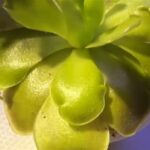As an Amazon Associate, this site earns commissions from qualifying purchases. For more details, click here.
Pinguicula agnata is native to the Mexican mountains, but now they are cultivated in many parts of the world. These butterworts are among the most effective in catching flies and they are also among the easiest to grow. If you want to nurture a pinguicula agnata, this guide will walk you through the process.
Pinguicula agnata are tropical butterworts that grow in full to partial sun. Use peat moss and perlite for the soil and keep the plant safe from frost. Pinguicula agnata needs to eat every two weeks except in winter when its leaves turn non-carnivorous.
Pinguicula Agnata Care Sheet
| Soil | 1:1 ratio perlite and peat moss, moist soil |
| Water | Spring, distilled, rainwater, reverse osmosis |
| Light | Partial to full light, 6-12 hours a day |
| Food | Small insects, fish flakes and pellets, worms |
| Temperature | 55-90 F (12.7-32.2 C) |
| Humidity | 50-80% |
| Dormancy | None, but carnivorous leaves are shed in winter, grows rosette |
| Propagation | Leaf cuttings |
Soil
The most common potting mix for agnata butterworts is 50/50 perlite and coarse sand. Plant the pinguicula in the soil and water until it gets moist.
There are other potting media options such as 1 part sand, 2 parts perlite and 2 parts vermiculite. Most tropical butterworts also grow well with sphagnum fiber and silica sand.
With so many options available, it can be confusing if you are a beginner. Fortunately, pinguicula agnata are sold with ready made soil. All you need to do is mix the materials according to the package instructions.
Once you have gained experience growing butterworts, you can try other mixing different types of media using various ratios. You can do this with leaf cuttings for instance.
Pot Container
Most pinguicula agnata are sold in 3-4 inch pots. That is the standard size for most butterwort plants and works fine here.
You do not need an expensive pot. Cheap plastic containers are fine and you can use Living Whole Foods Tray if you have several butterworts. If it is deep and wide enough for the roots, that will do. Whichever pot you use, it should have a clear drainage hole for water to pass through.
Because its roots are small, repotting is probably not necessary. Many growers leave their pinguicula in the same pot for years without any problems.
Still some pinguicula agnata variants may benefit from a new pot. If your butterworts are not eating and look sick, repotting may be the answer. This guide on when and how to repot butterworts shows you how it is done.
Water
Water the plant until the soil is moist. Do not use too much or the soil will turn soggy and damage the roots. Like other butterworts, pinguicula agnata roots are fragile and easily damaged.
Use water with 50 ppm or lower. You have to go with either reverse osmosis, distilled or purified water. You may also use rainwater if you can collect enough.
During its growth period, water butterworts regularly. Never let the soil get dry. You may use the tray method but pour only an inch of water. Add more when the tray dries up.
This should be enough to keep the soil moist. If it dries too quickly, water from the top. Overhead watering while the plant is sitting in water might seem risky. But if the tray method is not sufficient you can try this.
A bit of watering during its winter form is fine. When sprinkling water from the top, do not let the water sit on the rosette. Sprinkle around the rosette until the soil is moist.
Cut back on water during winter. Even though p. agnata does not go dormant, their growth and development slows at this time. They do not need as much water especially variants that turn succulent.
Once winter is over, you can water the plant regularly. Do this slowly so as not to shock its newly grown leaves.
Light
Butterworts need sunlight for photosynthesis, but too much of it can be harmful as well. Pinguicula agnata thrives in full sunlight but some species prefer filtered.
Like pinguicula weser, pinguicula agnata needs plenty of light to grow. If the temperature is between 55-90 degrees you may leave the plant outdoors. Higher temperatures usually means more sun. However the heat could damage the leaves. On solution is to shade the plant during the hottest part of the day.
Pinguicula agnata should get 6-12 hours of light daily. The intensity of the light is important too. If you live in a dry, arid area, a few hours of full, direct sunlight is enough. Move the plant under shade during the afternoon.
However if there is not enough natural light, use indoor plant fixtures like the Wolezek Plant Light. There are many to choose from and they work well with butterworts. Follow the instructions for their use and it should complement natural light.
Temperature
Pinguicula agnata should be grown in 55-90 F (12.7-32.2 C). The plant cannot survive in winter frost or 100 F and higher temperature.
Because these are tropical butterworts, some assume it is safe to leave the plant under full direct sunlight. While these plants benefit from sunlight, heat can and does burn leaves. High temperature and low humidity could dry out mucus, making it impossible to catch prey.
If the temperature in your area gets too hot in summer, take the plant inside and place it on a windowsill. Let it receive as much morning sunlight as possible. As the temperature rises at noon, move the plant away from the window or put it under partial shade.
If it gets too cold, bring your p. agnata indoors. You can keep tropical butterworts outside during spring, summer and fall. But when the temperature starts dropping, take it inside. Whether your butterworts grows succulents or remains carnivorous, do not expose it to winter freeze.
Humidity
Tropical butterworts prefer mild weather and mid to high moisture levels. Most p. agnata do well in 50-80% humidity. However, the right level will depend on the variant and other factors like sunlight, air flow and temperature.
You can use a humidifier to control the water vapor in the air around your butterworts. But you should focus on providing the right amount of sunlight, water, soil and temperature as described above. If you set these up properly, the humidity level will be sufficient.
Aside from sun and water, air circulation is crucial. Humidity enables the pinguicula glands to produce mucus on its leaves. However, too much humidity could precipitate root rot. High quality air flow will prevent this from occurring. Keep your pinguicula in mild temperature but never freezing.
Nutrition and Feeding
Pinguicula agnata needs to eat every two to three weeks. In most cases hand feeding will not be necessary. If the plant is outdoors there are lots of prey available. Unless you keep your windows and doors locked all the time, insects can still get in, and they will be drawn to the plant.
But if your p. agnata is not getting enough food, you have to provide nutrients. Aside from insects you can give it fish food or frozen worms. This guide on how to feed pinguicula will show step by step how to do it.
While nutrition is important, the growth environment comes first. Butterworts must be in an ideal setting to produce mucus and eat prey. Lack of sun, water, etc. will weaken the plant and eventually lose appetite. So cultivate as best as you can, then you may consider what to feed it.
Dormancy
Pinguicula agnata do not require dormancy. Most discard their carnivorous leaves in favor of non-carnivorous succulents. However there are some variants which remain carnivorous during winter. Regardless, you have to protect the plant from winter frost.
If your p. agnata turns into succulents, reduce watering. In some cases you may have to let the soil go completely dry, only misting it every few days. Other variants prefer lightly damp soil during dormancy.
If your butterworts remain carnivorous in winter, give it food. Even if they do not go dormant their growth slows, so do not be surprised if they do not eat much.
After 2-3 months, pinguicula agnata will come out of this dry dormancy / succulent phase. Carnivorous leaves will slowly grow again. This is usually the best time to propagate butterworts, and the easiest way to do this is by leaf pullings.

My fascination with carnivorous plants began many, many years ago with Venus Fly Traps. Now I am more than happy to impart what I know with other enthusiasts and those who are curious about meat eating plants.



